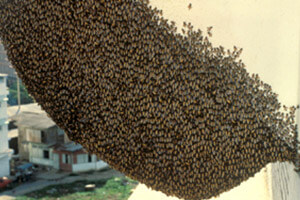
I knew Bergmann’s rule before I’d even heard of it. And I bet most of my readers do too.
My epiphany came on one of my trips back home to Indiana after I had moved to Louisiana to go to school at LSU. It was my first trip back to Indiana during summer-time, the previous trips having been limited to Christmas when the squirrels weren’t out. Squirrels, that is, because my epiphany had to do with squirrels, and summer-time because that meant it had been a long time since I’d been home. The first time I laid eyes on a Hoosier squirrel after years of absence I about jumped: they were so big they looked liked dachshunds running up the trees. It’s true. Indiana squirrels are bigger than Louisiana squirrels. And beekeepers who’ve had the opportunity to work bees in different parts of the country know that the same applies to honey bees as well: worker bees are bigger in Indiana than they are in Louisiana – or pretty much anywhere north versus south. Only later did I learn that this observation had been noted before: that animal body size increases as latitude increases. It can apply both within species and across species within a genus. It is general enough to be called a rule of biogeography, named after Carl Bergmann, the 19th C German biologist who first wrote about it in 1847.1 But it is far from universal, and in the case of insects may even be weak. Among the Hymenoptera, the order making up the ants, wasps, and bees, only 25 of 62 studies (40%) have confirmed Bergmann’s rule2, and among the bumble bees in particular the opposite seems to hold – that body size gets smaller as latitude increases (called “converse Bergmann”).3 I raise the issue at all because I think Bergmann’s rule has something to say in our evolutionary history of the honey bee, and what little information exists on the matter suggests that A. mellifera does indeed follow it.4
This month’s installment is about the evolution of body size in Apis mellifera, and in spite of my casual observation that worker bees are bigger in Indiana, readers of this column will know that a more insightful way to think about body size in the honey bee is to consider the superorganism – how many workers make up a colony? If it is true that a colony is analogous to a unitary, multi-cellular organism such as ourselves, then we can think about worker bees as cells of the body, and the more cells the bigger the body. Among members of its genus, A. mellifera has a relatively high worker population. A comparison of natural colony populations in the genus Apis is shown in the table along with other measures of interest, copied from Seeley5 and Dyer and Seeley.6
Colony population size is important for modern beekeeping, and by one’s first or second season a new beekeeper has learned to distinguish an unacceptably small population from a large one (Fig. 1). Basically, the more the better, and any deviation from this is a sign that something’s wrong. For example, Colony Collapse Disorder (CCD) is, by definition, a worker population proportionally small to the amount of brood.7
It was a USDA scientist, C.L. Farrar, who showed just how important large populations are to honey production. His landmark 1937 paper8 showed that honey hoarding efficiency increases as colony population increases. In other words, one colony of 50,000 bees can be expected to make more honey than the sum of two colonies of 25,000 bees. The historic importance of this discovery cannot be overstated, and I personally think C.L. Farrar has a claim to the beekeeping pantheon at least as great as our venerated L.L. Langstroth.
In one stroke, Farrar reinvented honey production management. Prior to Farrar, beekeepers were mostly concerned with large hive numbers. Swarms were considered a good thing as one now had two hives instead of one. The famous old beekeeping rhyme betrays this antiquarian point of view:
A swarm of bees in May is worth a ton of hay.
A swarm of bees in June is worth a silver spoon.
A swarm of bees in July ain’t even worth a fly.
Now I have to admit I’ve puzzled over the valuations used in this old ditty, so I went to Google and Amazon to enlighten me. A ton of alfalfa hay runs about $150-$250, and silver spoons from Amazon run about $86. But whether it’s May or June I think a new swarm would be hard-pressed to make anything close to that value in honey. After Farrar it was realized that swarming, by reducing a colony’s foraging force by half, is a severe blow to honey production, and today’s bee management is essentially the pursuit of very large colonies that don’t swarm. We can thank Farrar for feeding, reversing, splitting, combining, equalizing, cell-cutting, requeening, supering, and all the other things we do to prevent swarms and maximize colony size.
If large worker populations are good for the beekeeper, they’re also good for the superorganism, and today’s large worker populations in A. mellifera can be thought of as another optimized outcome of selection by natural forces. As we have seen in other characteristics of bees, colony population is a messy outcome of genetic evolution, physical constraints placed on the bee, and positive feedback loops that reinforce evolution of large populations.
To understand how this happened, we need to go back to the breeding ground of the genus Apis, Southeast Asia, and reconstruct the plausible pathways inferred from …


